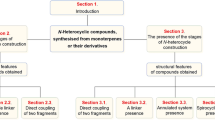Summary
A number of 3-hydroxy flavanones occur in nature and several have been obtained using a number of synthetic methods. Though they behave generally in the same way when subjected to drastic methods of dehydrogenation or dehydration, those obtained by substitution of flavanones in the 3-position seem to differ markedly from others in their reactions towards mild reagents such as dilute sulphuric acid and iodine. This is attributed to stereo-chemical differences. In this particular synthetic method the 3-hydroxyl is axial (H2O elimination easy) whereas in the others it is equatorial (H2 elimination easy). In flavanones substitution of the axially disposed C-H is the favoured one because it is sterically unhindered.
Similar content being viewed by others
References
Pew ..J. Amer. Chem. Soc., 1948, 3031.
Kotake, Kubota and IchikawaJ. Inst. Polytech., Osaka City Univ., 1950,1, 47.
Geissman and Lichner ..J. Amer. Chem. Soc., 1952, 3001.
Shimizu and YoshikawaJ. Pharm. Soc. Japan, 1952,72, 331.
Murakami and Irie..Proc. Imp. Acad. Tokyo, 1935,11, 229.
Reichel and Steudel..Ann., 1942,553, 83.
Guider, Simpson and ThomasJ. Chem. Soc., 1955, 170.
Oyamada..J. Chem. Soc. Japan, 1934,55, 785.
Marathe, Chandorkar and LimayeRasayanam, 1952,11, 48.
PZemplen and Bognar..Ber., 1943,76 B, 452.
Goel, Narasimhachari and SeshadriProc. Ind. Acad. Sci., 1954,39, 254.
Oyamada..J. Chem. Soc. Japan, 1943,64, 331, 471.
Kotake, Sakan and KubotaChem. and Ind., 1954, 1562.
Cavill, Dean, McGookin, Marshall and RobertsonJ. Chem. Soc., 1954, 4573.
Mahesh and Seshadri .. Under publication.
Kotake and Kubota..Ann., 1940,544, 253.
Lindstedt..Acta Chem. Scand., 1950,4, 772.
Oyaraada..J. Chem. Soc. Japan, 1934,55, 755.
Kubota..Ibid., 1952,73, 571.
Gripenberg..Acta Chem. Scand., 1953,7, 1323.
— and Juselius..Ibid., 1954,8, 734.
Jouanneteau, Zwingelstein and MentzerComptes Rendus, 1954, 1514.
Kotake and Kubota..Ann., 1940,544, 250.
Molho, Coillard and MentzerBull. Soc. Chem. (under publication).
Kubota..J. Chem. Soc. Japan, 1938,59, 1153.
Narasimhachari and SeshadriProc. Ind. Acad. Sci., 1949,30 A, 151.
Barton ..J. Chem. Soc., 1935, 1029.
- and RosenfelderIbid., 1951, 1048.
Cahn, Phipers and BoamIbid., 1938, 513.
Gupta and Seshadri ..Ibid., 1954, 3063.
Author information
Authors and Affiliations
Additional information
Naturally occurring 3-hydroxy flavanones are specified by their trivial names and the synthetic ones by the method of preparation.
Rights and permissions
About this article
Cite this article
Mahesh, V.B., Seshadri, T.R. Stereochemistry of 3-hydroxy flavanones. Proc. Indian Acad. Sci. 41, 210–223 (1955). https://doi.org/10.1007/BF03047207
Received:
Issue Date:
DOI: https://doi.org/10.1007/BF03047207




